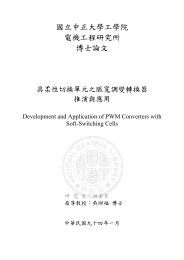Syntax of the Bi Comparative Construction in Mandarin Chinese
Syntax of the Bi Comparative Construction in Mandarin Chinese
Syntax of the Bi Comparative Construction in Mandarin Chinese
You also want an ePaper? Increase the reach of your titles
YUMPU automatically turns print PDFs into web optimized ePapers that Google loves.
<strong>Syntax</strong> <strong>of</strong> <strong>the</strong> <strong>Bi</strong> <strong>Comparative</strong> <strong>Construction</strong> <strong>in</strong> Mandar<strong>in</strong> Ch<strong>in</strong>ese<br />
(6) a. wo gao Lisi san gongfen [CC without bi]<br />
I tall Lisi three centimeter<br />
‘I am three-centimeters taller than you are.’<br />
b. gege da ni san sui<br />
bro<strong>the</strong>r old you three year<br />
‘My bro<strong>the</strong>r is three years older than you.’<br />
Although it seems that many BCC sentences have correspond<strong>in</strong>g forms <strong>in</strong><br />
sentence patterns without bi like (6), we can still f<strong>in</strong>d out some restrictions on CC<br />
without bi. First <strong>of</strong> all, only adjectival verbs 3 can be <strong>the</strong> compar<strong>in</strong>g dimension (<strong>the</strong><br />
predicate) <strong>in</strong> CC without bi. Gradable non-adjectival verbs such as xihuan ‘like’ <strong>in</strong> (7)<br />
cannot occur <strong>in</strong> this pattern. Moreover, <strong>in</strong> BCC <strong>the</strong> measure expressions like san<br />
gongfen ‘three centimeters’ is <strong>in</strong> complementary distribution with <strong>the</strong> degree adverb<br />
geng; however, it is obligatorily to occur <strong>in</strong> CC without bi, and <strong>the</strong> occurrence <strong>of</strong> <strong>the</strong><br />
degree adverb geng makes <strong>the</strong> sentence unacceptable. 4 Therefore, we consider <strong>the</strong><br />
superlative construction without <strong>the</strong> marker bi is different from BCC like (4), and thus<br />
exclude this pattern <strong>of</strong> CC from this study.<br />
(7) a. * wo bi Lisi (*geng) xihuan xiezuo shi bei<br />
I COM Lisi more like writ<strong>in</strong>g ten times<br />
‘I like writ<strong>in</strong>g (ten times) more than Lisi.<br />
3 In Mandar<strong>in</strong>, words like gao ‘tall’ should be categorized as adjectives, verbs, or even adjectival verbs<br />
has long been a controversial issue. In this study, we take those ‘adjective-like’ words as one k<strong>in</strong>d <strong>of</strong><br />
predicates-adjectival verbs.<br />
4 As cited by Chao (2005:35), (von Stechlow 1984, Kennedy 2001, ect.) English comparative<br />
sentences with <strong>the</strong> measure phrases like (i) are termed as Differential <strong>Comparative</strong>s. Therefore, <strong>in</strong> our<br />
analysis CC without bi is taken as Differential <strong>Comparative</strong>s, while BCC is Degree <strong>Comparative</strong>s.<br />
(i) John is 3 <strong>in</strong>ches taller than <strong>Bi</strong>ll (is).<br />
4<br />
中正大學 e-Thesys (94 學年度)





